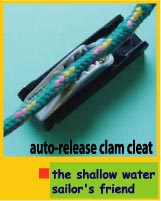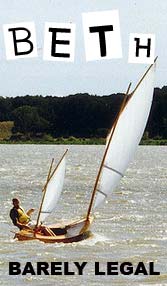
What is SEA ROVER?
Mainly it is the result of my some 60 years in and around the boating scene. Builder, designer, author, sailboat racer and — to be sure - dreamer.
During the years after I had founded the International Amateur Boat Building Society and published Amateur Boat Building magazine, I found that only about 10 percent of the members actually built a boat. Fellow dreamers! But now is the time to stop dreaming and start building and start boating!
What's holding us back?
Time, money, skill, water access, other obligations? (Do I dare say laziness?)
What is needed in your boat?
FREEDOM to do as you please. Have fun, start a business, just come and go when you want to.
AFFORDABILITY that does not put a dent in your budget. Let's say less than $1,000.
FLEXIBILITY to build your boat the way you want it. The freedom to customize it with the features you need and want.
EASE OF BUILDING that does not demand expert—level carpentry. Something you can do if you have built a bird house. And something you can do with the help of people who have done it. Plans include detailed step-by-step building instructions.
This project uses the "Quick-and-dirty" (means: EASY) method championed by the late, great Harold "Dynamite" Payson, with whom I spent many a happy hour in his Maine building shop.
FUN — well let's call it enjoyment because there really aren't many laughs on a small boat in the middle of a thunderstorm. But do add adventure, thrills and the self-satisfaction you feel knowing you built it, piloted it and yes you really did have fun because you know when action is enjoyable.
A BUSINESS OPPORTUNITY? This is a plus because I have been self-employed most of my life and "how does this make money'?" — is always on my mind. Sea Rover is flexible enough to allow many uses. Fishing, light salvage, SCUBA, just good old gunk-holing, and my favorite - photography, which I learned during my early days with the Associated Press. People love photos of their boats (more than of the kids?) And you can catch them in action. Especially the racing boats. This is why I show the "hitchin' post"· on the cabin top. You stand up there and lean against this while shooting pix. (Note also that you can steer the boat from up there with a tiller extension) And now I must explain the Land Rover spare wheel on the "hood". This is an auto tire innertube and you use it to stay afloat when you are in the water taking low angle pix of boats.) Or you can just play with it in the surf.

A NEW HOME? If worse comes to worse and you can live on fish, you can live aboard. Well, not in luxury, but you have shelter and a "patio" and running water, a toilet and even a small stove and two bunks. Location? Pick where you want to be and go there!
A few words about the design
Yes, Sea Rover is small. It would be nicer at 20 feet, 120 feet, 200 feet, etc. But a small boat is better than no boat. The cost is small, the power requirement is small and the gas bill is small and the upkeep, dockage, painting and this and that are all small - and affordable.
Much has changed since the old Colin Archer "ice-breakers" with two-inch-thick planking. Plywood got invented. (And so did fberglass, of which I use none. It is expensive, smelly and itchy.)
SR has only three frames plus the bow and transom. The structure is monocoque to a large degree and seats, bunks and such add to the overall strength. Plus this uses my own "XO///FRAME" where part of the structural frame is on the outside of the hull. Yes, it looks a bit odd, but this is the perfect oddboat for this unique, but very practical treatment!
SR is basically a scow. No pointy end. This is a boat for sheltered, inshore use; rivers and lakes and such. At speed, it planes and so there is no need for a sharp bow. This also is a very stable platform, unlike a 12-foot canoe where you cannot stand up. On SR you can standup and run around and do all sorts of things — some in the cabin.
SEA ROVER
Design by Jim Betts Jan. 2014
LOA l2'-4" Beam 7'-4" Draft 5"
Displ. 647 pounds HP Max. 30 HP
Max. Passengers 4. Weight 742 lbs.
Fuel up to 35 it gals. Range 400 miles
Fuel consumption 11.42 miles per gallon @ 8 knots
Speed to 30 knots Planes at 10 knots
© 2014 by Jim Betts
What the SEA-OVER program offers you
With the study plan and program outline you get a few other things:
1. You get regular mailings of news of the progam, building activity, design ideas, any changes and updates.
2. You get news of the formation of building clubs in your where you may share the work with others and they may share with you.
3. You get technical information from me and just chat about the program.
4. Exploration of a "Mutual Building Fund" program where you pool small amounts or money to help others get their boat and — in return- you collect when you start yours. (Yes, this is very much in the thinking stage and has some legal ramifications, but I am working on it.)
5. I may start to build boats here in NJ for sale ready to launch if there is any market for them. Could also use a few licensed builders in other areas. Maybe!
6. Anyone interested in a race? Lets's say a few days at a nice lake where we have a few short (say two-hour) races and a nice 24-hour race with crew of maybe three. Refueling stops and all that, just like the 24 Hours of Le Mans for cars. But you must all sleep and eat aboard. (Do you know that sailboat racing is thc only sport you can participate in while you arc asleep? - Bermuda Race, Trans-Pac.) And you can, eat, sleep, play cards, drink, and some other things that we will not mention.

GP-16 (General Purpose and 16 feet LOA, which I co-designed some years ago, is similar to SEA ROVER in basic shape. Here you see me doing 35 MPH with 45 HP. Sixteen were built, but the plans are no longer offered.
Ergonomics and how you fit into a Sea Rover

As Nathaniel Herreshoff said, "If you want to stand up, go on deck!" So there is just 5 feet of headroom in the cabin, made necessary by the need to see over it when standing. When you are seated, you can see ahead fairly well through the large cabin windows. Anyway, seats are hard and you will want to stand now and then. The entry from cockpit to cabin is five feet high, so you crouch a bit. There is no hatch, which makes the cabin roof stronger and less cluttered. If you want a hatch, build one.
A few added thoughts:
You could fit a double berth in the cabin by turning it athwart and make it maybe 4 ft. wide.
Put the head under berth or cockpit seat.
Mount stove so it may be used in the cabin or on deck. Use a bucket for a sink. Put ice in one of the cockpit seat lockers.
Keep a boarding ladder so that it may be quickly mounted. Or have a boarding rope ladder with lanyard over the side so that you can pull it down when you are in the water.
Electric or manual start? Both would be a plus. Electric needs a battery and this could also power lights. (But additional manual-start is a good idea in case you drain the battery.)
The cockpit is not self-bailing so you need to have a cover to keep out the rain when you are not aboard. Have a good bilge pump! This could also serve as an awning over the cockpit with supports on top of cabin and at transom. (Use boat hooks as supports.)
You may control the motor (except for shift) from cockpit, cabin and even cabin top, so you may be on cabin top shooting photos and have control of direction and speed at same time. This uses tiller extension available from West Marine: Twist-Lock Model 111914. $92.
Fuel may be in six-gallon plastic cans you can take ashore to refill, or permanent metal tank(s) under cockpit seats. (See USCG regulations on tank installation. This is in the CG publication "Safety Tips for Back Yard Boat Builders," which you should have and study. You get this 50-page publication on the web in a printable form HERE.
You could make the boat a bit longer by simply stretching it two feet and adding another frame in the cockpit area between the transom and cabin bulkhead If you are simply going to putt-putt around, use a smaller motor. (Always look around for a used motor. Lots of people trade smaller ones on a larger model.)
Depending on your intended use, you may want to leave the seat/lockers out of the cockpit in part and gain more deck space there. Then use folding chairs as needed and stow them on the cabin top.
Remember to round off all edges with which you may come in contact. People fall down on boats a lot and you do not want to hit your head on a sharp edge!
Many features of SEA ROVER may be changed by you. But be sure you don't create new problems and make changes that lead to trouble. When in doubt contact me for guidance.
by Jim Betts
*****
plans available at Duckworks |










